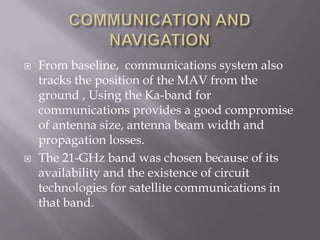Micro air vehicles
- 1. Presented by Akhilesh 09h51a0302
- 2. ïĻ Micro air vehicles is an unmanned air vehicle that has size restrictions and autonomous. ïĻ These are small light weight , and autonomous that can fix in a back pack used to perform tasks in a near earth environment. ïĻ Micro air vehicle is small enough to fit in our hand , and operating range of several kilometers and transmit detailed pictures back to portable base station.
- 4. ïĻ Size should be less than 15cms, To the human eye, an MAV in flight would resemble a small bird. ïĻ The projected MAV airspeed of 10 to 15 m/sec which is below the minimum velocity of most radars. ïĻ Operating in an approximate radius of 600 metres from the launch point, ΞAVs are used to acquire real-time visual information for a wide range of applications.
- 7. ïĻ The simplest design is an MAV that can remain within the line of sight of a small base station. ïĻ Base station tracks the vehicle, maintains the communications link, and performs navigation calculations. ïĻ For Navigation GPS is used since it can be available in small components. ïĻ Alternatively, the MAV might be able to perch, or fasten itself to a fixed object, or turn into a crawler for local sensing
- 9. ïĻ Size comparison of existing unmanned air vehicles (UAVs) and proposed MAVs. ïĻ The profile of a soldier scale, represents six feet. ïĻ The smallest known UAV for defense applications currently flying is the Naval Research Laboratory Self-Navigating Drone Expandable/Recoverable (SENDER), which has a 1.2-m wingspan. ïĻ The proposed MAVshave wingspans of 7.4 cm and 15 cm, or 3 and 6 in.
- 12. ïĻ Model of Lincoln Laboratory concept of the smallest possible MAV (7.4-cm wingspan) with a visible imager for reconnaissance missions. This bottom view of the model shows the down looking camera port in the nose
- 13. ïĻ If we use an electric motor with 60% efficiency, the baseline electrical power is 4.2 W. ïĻ These values, however, provide only enough power for level flight, and they must be doubled so that the MAV can turn, climb, and fly in gusty air. ïĻ To produce this power, we considered a variety of efficient and lightweight propulsion systems , micro turbines including electric motors powered by batteries.
- 14. ïĻ MAV flight-control system. Flight control requires sensors that measure motion (roll, pitch, and yaw) of theMAV, and aerodynamic control inputs that stabilize and maneuver the MAV in wind gusts and turbulence.
- 16. ïĻ From baseline, communications system also tracks the position of the MAV from the ground , Using the Ka-band for communications provides a good compromise of antenna size, antenna beam width and propagation losses. ïĻ The 21-GHz band was chosen because of its availability and the existence of circuit technologies for satellite communications in that band.
- 17. ïĻ An MAV could provide significant new capabilities to a wide range of users. ïĻ Several MAVs and a base station could be transported and operated by a single individual, providing real-time data directly to the local user. ïĻ A variety of vehicle configurations and sensors could be used for many possible missions.
- 18. Disaster Management ïĻ Fire. ïĻ Earth quakes. ïĻ Gas leakage. Commercial ïĻ Television. ïĻ Photography. Defense and security. ïĻ Surveillance and reconnaissance. ïĻ Explosive and Mine detection. ïĻ Counter terrorism. ïĻ Bio and Harmful gases like NOVA 6 detection.



















